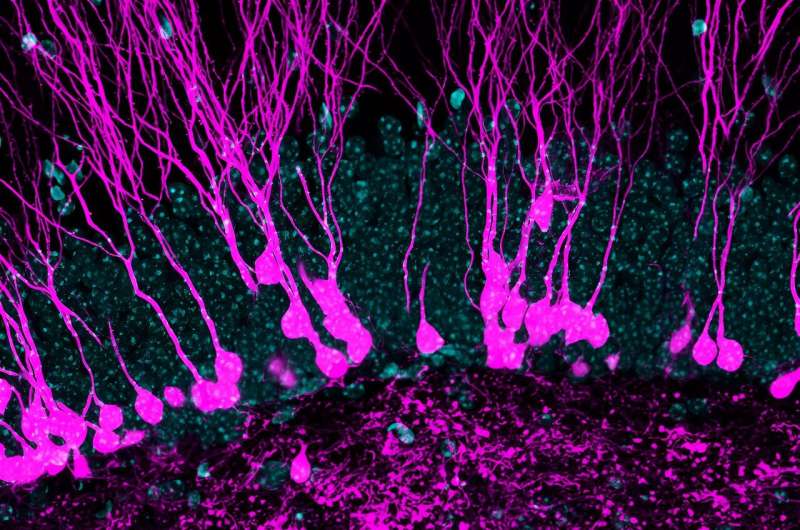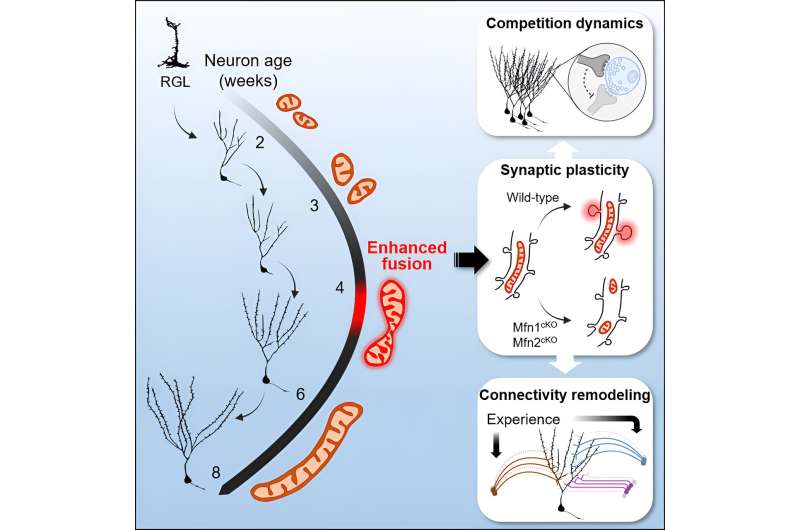This article has been reviewed according to Science X's editorial process and policies. Editors have highlighted the following attributes while ensuring the content's credibility:
fact-checked
peer-reviewed publication
trusted source
proofread
New study suggests enhanced mitochondrial fusion fuels nerve cell function and plasticity

Nerve cells (neurons) are among the most complex cell types in our body. They achieve this complexity during development by extending ramified branches called dendrites and axons and establishing thousands of synapses to form intricate networks. The production of most neurons is confined to embryonic development, yet few brain regions are exceptionally endowed with neurogenesis throughout adulthood.
It is unclear how neurons born in these regions successfully mature and remain competitive to exert their functions within a fully formed organ. However, understanding these processes holds great potential for brain repair approaches during disease.
A team of researchers led by Professor Dr. Matteo Bergami at the University of Cologne's CECAD Cluster of Excellence in Aging Research addressed this question in mouse models, using a combination of imaging, viral tracing and electrophysiological techniques. They found that, as new neurons mature, their mitochondria along dendrites undergo a boost in fusion dynamics to acquire more elongated shapes. This process is key in sustaining the plasticity of new synapses and refining pre-existing brain circuits in response to complex experiences.
The study "Enhanced mitochondrial fusion during a critical period of synaptic plasticity in adult-born neurons" has been published in the journal Neuron.

Mitochondrial fusion grants new neurons a competitive advantage
Adult neurogenesis takes place in the hippocampus, a brain region controlling aspects of cognition and emotional behavior. Consistently, altered rates of hippocampal neurogenesis have been shown to correlate with neurodegenerative and depressive disorders.
While it is known that the newly produced neurons in this region mature over prolonged periods of time to ensure high levels of tissue plasticity, our understanding of the underlying mechanisms is limited. The findings of Bergami and his team suggest that the pace of mitochondrial fusion in the dendrites of new neurons controls their plasticity at synapses rather than neuronal maturation per se.
"We were surprised to see that new neurons actually develop almost perfectly in the absence of mitochondrial fusion, but that their survival suddenly dropped without obvious signs of degeneration," said Bergami. "This argues for a role of fusion in regulating neuronal competition at synapses, which is part of a selection process new neurons undergo while integrating into the network."
The findings extend the knowledge that dysfunctional mitochondrial dynamics (such as fusion) cause neurological disorders in humans and suggest that fusion may play a much more complex role than previously thought in controlling synaptic function and its malfunction in diseases such as Alzheimer's and Parkinson's.
Besides revealing a fundamental aspect of neuronal plasticity in physiological conditions, the scientists hope that these results will guide them toward specific interventions to restore neuronal plasticity and cognitive functions in conditions of disease.
More information: Enhanced mitochondrial fusion during a critical period of synaptic plasticity in adult-born neurons, Neuron (2024). DOI: 10.1016/j.neuron.2024.03.013. www.cell.com/neuron/fulltext/S0896-6273(24)00167-3



















